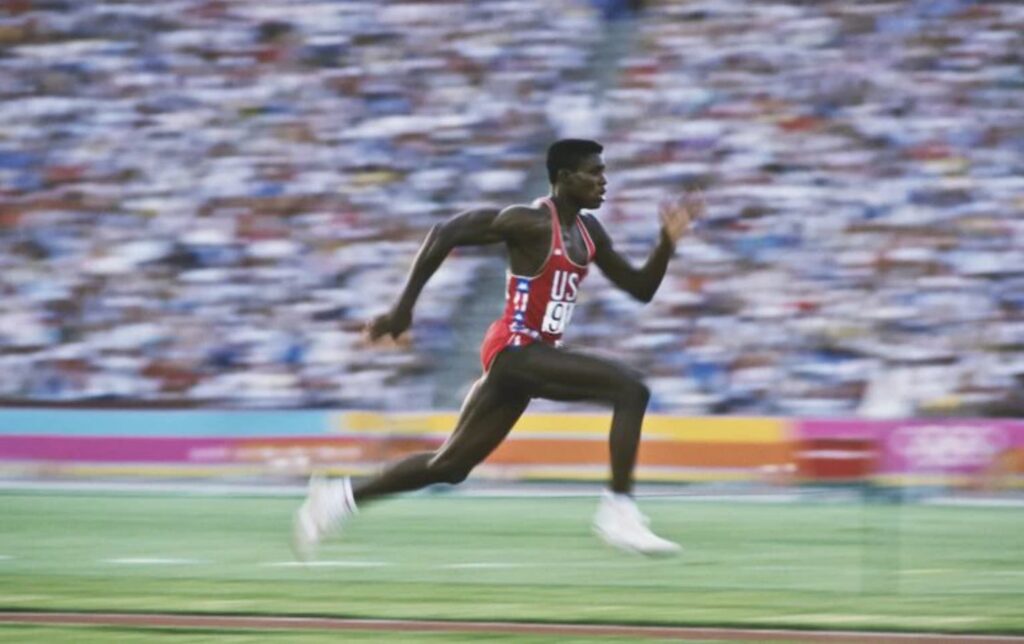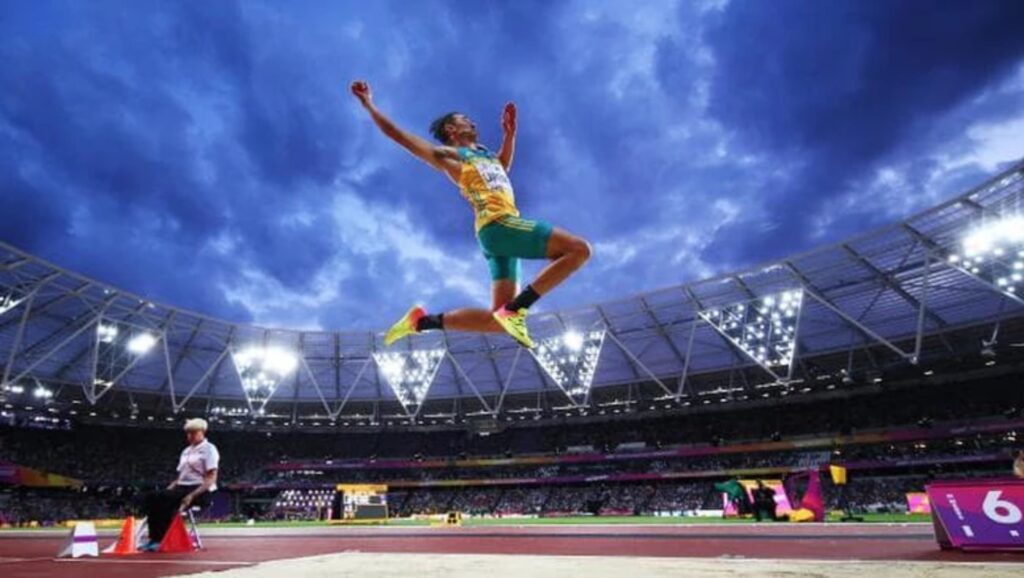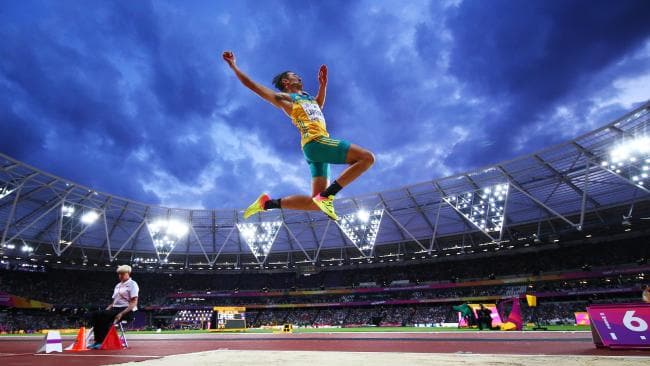The long jump is incredibly technical in nature. You can be fast, you can jump, you can be flexible, but you cannot just sprint down the runway and jump like Mike Powell or Carl Lewis. You have to know how to put together each part so that the most amount of energy is transferred from your approach into your take-off, and that as much forward-moving (kinetic) energy as possible is used during the flight in preparation for the landing, and then you have to train each individual part until you’ve mastered it. Let’s take a brief look at each of these four parts of the long jump and describe in detail the mechanics that make you jump further.

The Approach
The full approach is 90% of the jump – train hard here! The more controlled speed you have, the greater the amount of energy you will have to put into the jump, so training acceleration and controlled top-end speed are key to a great jump. During the approach, you should build up and maintain control, approaching 90% to 95% of your absolute top speed. Remember: if you go too fast and you won’t be able to control your take-off.
Judge your distance early to ensure a fair jump. If your toe crosses the line, you’ve wasted an opportunity for a great jump. Depending on your age group, you may want to consider the following for training distances:
- 12 and under: use a distance of eight to ten steps
- 13-15: use ten to twelve steps
- 16-18: use twelve or more.With more experience, try adding additional distance and practicing your approach. College-level athletes should be utilizing as much runway as possible without losing a) speed or b) accuracy at the take-off. Your body position should be upright at the Plant. If you’re leaning over or backward, you will lose the ability to jump efficiently, and risk lower back or hamstring injury. The last four steps (that is, the last four times your take-off foot takes a step):
- 4th from last: Know the distance to the board!
- 3rd from last: Adjust stride to make the Penultimate step.
- 2nd from last: the “Penultimate” step. Lower the hips and prepare for take-off. Shorten your step slightly to be quick off the Penultimate and keep yourself from “pausing” here.
- Last step: the “Plant”. Make it fair. A short fair jump is better than a long foul. Focus on landing flat-footed to prepare for driving the opposite knee upward during the take-off.
Training Tips: the Approach
In order to build up a great Approach, make sure to include 8-Step acceleration drills on the track (6 steps for younger athletes), and measure your final step placement with the aid of a teammate or coach. You should be able to consistently land within a 6-inch-wide area. As with all sprinting, A-skips and B-Skips are essential to training your muscles and tendons to the mechanics of the sprint, and are vital as an injury prevention measure. B-Skips in particular train your hamstrings when to release during a sprint and when to engage on the uptake. Given the additional strain put on these areas during the long jump, don’t miss out on B-Skips!
The Take-Off
After your Penultimate step in the Approach, you make the Plant: your final step. It is from here that the jump takes place. This is the take-off. You planted your foot nice and flat so you can jump with the full force of your musculo-skeletal system.Your body will move up and over the take-off leg with the knee of the free leg driving upward. The body is slightly behind the take-off foot but rises up while moving forward.
Since you shortened your step slightly with the Penultimate Step, you gain longer contact time with the take-off foot on the board. This is key to a quality jump. Your arms at this point will cease their standard sprinting alternation and swing up forcefully. The free leg is driven up aggressively, with the knee driving up and the foot tucked and the toe pointed up.
The key is to have a great knee drive and to have a tall take‐off from the board, jumping UP as much as OUT.
Training Tips: the Take-Off
No one likes getting their knee as high as possible during A-Skips or other drills, but it really is that simple. You want a good take-off? Drive that knee UP! Additionally, you should move your 8-Step Acceleration to the long jump runway and add a take-off. Practice landing flat-footed with your hips slightly lowered and driving the knee and arms upward into a solid take-off.

The Flight
Yes, the age old question: run in the air? Pike it out? Ballerina split leap across the pit?
The easy answer is that style in the air is not important.
The difficult realization with that answer is that the mechanics of the flight are important.
The dual purpose of in-air mechanics is to minimize forward rotation and set up a proper landing position.
In order to best accomplish this purpose, we’ll define one technique, knowing that it is not the only technique out there, and that you may be instructed to havea different “style” by someone else. Just remember: style in the air is not important if you can achieve the mechanics and meet the dual purpose of those mechanics.
Start with your free leg returning underneath you, similar to running one step while in the air. Keep the upper body tall with a flat back. You must stall the natural rotation of the body in the air as long as possible by rotating the arms high above head. Bring heels up tight under butt and lift the knees. This will prepare you for The Landing phase of the flight, after you pass the peak of you arc in a jump.

Training Tips: the Flight
Have a coach or teammate take slow-motion video of your jump from the side, so that you can see your body motions during each phase of the jump. Use the video to help you compare what you think your body is doing versus what it is actually doing. Be sure to stretch and to do extra mobility exercises for your hips in order to open them up and allow more fluid motions in the air.
The Landing
After the peak of the flight, your arms should sweep forward and down to your hips. Extend your feet out in front of you just before you hit the sand. Drive your arms forward and down past the hips just prior to landing if possible. Make sure that your feet land ahead of center mass, and do not sit or fall backwards in the pit. The butt should slide over the first feet imprints. When you get up, walk out the end of the pit. If you walk backwards through the pit, you’ll be disqualified. If you fall backwards when you land, that part behind you where your hand hit the sand is where your jump will be measured, not your feet.
Training Tips: the Landing
Use the same slow-motion video to analyze your landing and tweak portions of it accordingly. Look at how flat Bob Beamon gets during the landing phase of his jump in the image below. If you aren’t flexible enough to do that, you should probably work on your flexibility.

Mastering the long jump takes years of practice, and even then is a challenge that you’ll constantly pursue as you change and develop as an athlete. There are so many great resources online and at your local library on the long jump; thank you for taking the time to read this one, and don’t stop here! The search for knowledge and learning should never cease!

